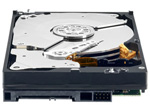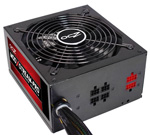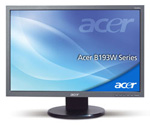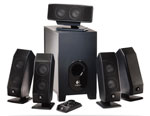Value Midrange Common Components
AMD and Intel architectures differ in sockets and sometimes memory configurations, but there is more in common than not between the two systems. For that reason the Intel and AMD value midrange systems share a number of components.
 |
The video card choice is an upgrade from the last midrange guide. The choice three months ago was the ATI 4850 512MB, but today we can recommend the ATI 4870 1GB for about the same price. The HIS H487FN1GP 1GB is just $130 after a $20 rebate. That excellent value made this card the video choice for both the Intel and AMD systems. Even without the rebate you can now find a 1GB 4870 for around $150. Our recent graphics card buyers' guide recommended the 4850 512MB as the best value in the $130 to $150 price range. Now you can spend the same $130 to $150 and get a more powerful 4870 with double the video memory. You will certainly be happy with the gaming capabilities of the 4870; it is an excellent match to the true HD video resolution of the 23" monitor chosen for the value midrange systems.
On the Intel system, the GIGABYTE GA-EP45-UD3P motherboard provides a second PCI x16 slot. Video performance can be improved even further by adding a second Radeon HD 4870 1GB in CrossFire mode. You can also upgrade to the 4890 1GB for more power at higher resolutions with "eye candy" turned on. The 4890 1GB upgrade adds about $50. The motherboard choice for AMD is the GIGABYTE GA-MA790X-UD4P, which also provides multiple x16 slots for CrossFire, although the two slots each run at x8 when both are populated. The same video options apply to the AMD value midrange system.
 |
1TB hard drives are now a routine hard drive capacity. The 1TB drives are large, fast, and stable, so it was easy to recommend the Western Digital Caviar Black 1TB drive (1000GB) at $95. There are cheaper 1TB drives available and there are many brands available with 1TB capacity. However, the Caviar Black has earned an enviable reputation for stability and performance. While there are differences between hard drives, outside of running benchmarks most people aren't likely to notice the difference in performance between Western Digital, Seagate, Samsung, Hitachi, and other major brands. All are worthy of consideration if the price per gigabyte (or terabyte) is right.
 |
Since many readers complained that Blu-Ray playback was an unnecessary expense in a value midrange system, we downgraded the optical drive to a fast DVD burner. Fortunately, DVD burners have just seen the introduction of faster burning speeds and the Sony Optiarc 24X has emerged as a favorite in recent system builds. This Sony DVD burner is the choice for both best value midrange systems. It can burn DVDs as fast as 24x speed and it supports both single and double layer media. If you like the ability to read 25GB/50GB Blu-Ray disks you can upgrade to the LG CH08LS10 Blu-Ray/DVD combo drive used in the performance midrange systems. Adding that capability increases the cost about $100.
Cases are often very personal choices when it comes to features, and you may already have a favorite. If you don't you should definitely look at the recommended Antec Three Hundred. The Three Hundred is a bottom-mount power supply design. Some love this configuration, others hate it, but it works well in the Three Hundred. It is definitely reasonable at the current $60 cost, but that does not mean it is a "cheap" case. It comes standard with a 120mm rear exhaust fan and a 140mm top fan, which both feature a 3-speed switch. There is also room to mount two additional front 120mm fans behind a washable dust filter, so you can effectively cool anything from a single hard drive to a large RAID array. Inside there are nine drive bays - six internal 3.5" and three external 5.25" drive bays. Front USB, headphone, and microphone jacks are also standard and they are conveniently located at the top of the front panel. That makes them usable in the common "on the floor" setup.
If you prefer a more traditional case configuration the Cooler Master Mystique, selling for $80, mounts the PS on top, provides font panel jacks, and is loaded with expansion ports and two 120mm fans.
 |
The Editors' Choice BFG Tech LS-550 power supply has been discontinued. The new power supply choice for the value midrange systems is the excellent OCZ ModXStream Pro 600W. The ModXStream is 80 Plus certified and a modular design. That means you use only the cables you need for your system, which makes cable management a much easier task. This OCZ is also a great value right now at $60 after a $20 rebate. The PSU is also SLI certified and CrossFire Ready.
 |
The last major component to discuss is the display, and here the tilt was toward best value at full 1080p HD (1920x1080) resolution. Six months ago we chose a "new class" of 16:9 21.5" LCD monitors that provided true 1080p resolution at the then break-through price of just $199. Now we can choose a larger Acer 23" (nominal 24") monitor for even less at $180. It is also worth mentioning that the Acer 23" is one of the few monitors in its class that comes with all three video cables. Yes, an HDMI cable is included in the Acer box. Some buyers want the cheapest monitor they can find. The ASUS 21.5" chosen in earlier Buyers' Guides is now $149 after a $10 rebate. The resolution is the same as the Acer 23". Choosing the ASUS 21.5" instead saves you about $30 for those on a tight budget, with a reduction in pixel pitch from 0.271mm to 0.248mm.
 |
The Logitech X-540 has been a favorite of users looking for a reasonably priced but good performing, powered 5.1 computer speaker system. At $79 it will certainly not challenge the performance of a separate Dolby amplifier powering audiophile speakers, but it will provide surprisingly good sound for the price. The Creative Inspire T6100 76W 5.1 speaker system is a similar powered speaker system that is selling at about the same price as the X-540. Either speaker system is a good choice for these value midrange builds.
These are clearly desktop systems, so the keyboard and optical mouse are the basic Microsoft OEM kit. If you have specific needs or a favorite gaming mouse, you likely know exactly what you prefer. The Microsoft pair is very capable for most. For greatest compatibility we have chosen Microsoft Vista Home Premium OEM as the operating system. Unless you have specific networking and special enterprise security needs there is no real reason to pay the extra for Vista Ultimate.










71 Comments
View All Comments
SiliconDoc - Wednesday, August 5, 2009 - link
The idea that the 4870 or the 4890 beats the GTX275 is a FANTASY.-
http://www.driverheaven.net/reviews.php?reviewid=7...">http://www.driverheaven.net/reviews.php?reviewid=7...
http://www.bit-tech.net/hardware/graphics/2009/04/...">http://www.bit-tech.net/hardware/graphi...03/radeo...
http://www.bjorn3d.com/read.php?cID=1539&pageI...">http://www.bjorn3d.com/read.php?cID=1539&pageI...
http://www.dailytech.com/422009+Daily+Hardware+Rev...">http://www.dailytech.com/422009+Daily+H...adeon+HD...
http://www.guru3d.com/article/geforce-gtx-275-revi...">http://www.guru3d.com/article/geforce-gtx-275-revi...
http://www.legitreviews.com/article/944/15/">http://www.legitreviews.com/article/944/15/
http://www.overclockersclub.com/reviews/nvidia_3d_...">http://www.overclockersclub.com/reviews/nvidia_3d_...
http://www.hardwarecanucks.com/forum/hardware-canu...">http://www.hardwarecanucks.com/forum/ha...a-geforc...
http://hothardware.com/Articles/NVIDIA-GeForce-GTX...">http://hothardware.com/Articles/NVIDIA-GeForce-GTX...
http://www.engadget.com/2009/04/02/nvidia-gtx-275-...">http://www.engadget.com/2009/04/02/nvid...275-ati-...
http://www.overclockersclub.com/reviews/nvidia_gtx...">http://www.overclockersclub.com/reviews/nvidia_gtx...
http://www.pcper.com/article.php?aid=684&type=...">http://www.pcper.com/article.php?aid=684&type=...
-
If you're spending $700.00 to $1,600 dollars and a $15 difference on one of your most important components, the videocard, makes your mind up for you... well...
---
NVidia often has 1 or TWO free games with it at the egg - while the red card far less often has just 1. There's another $50 - or $100, going with Nvidia - because of course with either card that makes it a GAMING system - and one would need some games.
---
I wasn't surprised that EVERY CARD in EVERY SYSTEM recommended was the red rooster card - considering where we are.
Mirrorblade - Monday, July 27, 2009 - link
Hiya, for HDD choice you write"While there are differences between hard drives, outside of running benchmarks most people aren't likely to notice the difference in performance between Western Digital, Seagate, Samsung, Hitachi, and other major brands." -
but for memory, you recommend an overclocking memory set, where you could easily save some money (and you don't even give an alternative "for the people that will never want to overclock at all).
.. I don't see any point in advising only overclocking stuff. Sure one might want to overclock, but in this case you could add something as an alternativ, not recommend the OC stuff in general.
Wesley Fink - Monday, July 27, 2009 - link
Even if you never overclock the low-voltage designs of the memory we recommend in the Guide will perform well and last a last time. You can certainly substitute lower cost and lower spec'ed memory if that better meets your needs.Search for a standard like DDR2-800 for the DDR2 systems and DDR3-1066 or 1333 for the Performance mid-range systems. Name brand memory with a real warranty is the better choice - even at the low end. If anything goes wrong quality memory suppliers will replace the bad memory quickly and many better companies offer a lifetime memory warranty.
In comparing memory at the same price choose the one that has the tighter timings, like 5-5-5 instead of 7-7-7. At the same timings and price the one that is specified with the lower voltage is generally the better choice.
nafhan - Monday, July 27, 2009 - link
I think they recommended overclocking memory because they are recommending overclocking in general at this price point. Notice the processor and motherboard choices are geared towards overclocking as well. If you are definitely NOT going to overclock the value midrange, you could buy cheaper memory, motherboard, and (on the AMD side) a non-black edition CPU. You'd save about $100, and still have a fast, reliable system.It might be interesting if they listed a non-overclocking alternative for those parts (Mem, CPU, MB). Although, that may just push things down into the "budget" system range.
IlllI - Monday, July 27, 2009 - link
can anyone tell me if the OCZ ModXStream Pro is better than the ENERMAX PRO82+ http://www.newegg.com/Product/Product.aspx?Item=N8...">http://www.newegg.com/Product/Product.aspx?Item=N8... ? they are both about the same priceThe0ne - Monday, July 27, 2009 - link
I don't know about the enermax but I've researched before purchasing my OCZ 700W PS. Their lower wattage PS have good reviews except for this one but with the recent updates it's gotten better reviews. It was below average before. Sorry I don't have the link to the website that reviews PS.One thing to keep in mind is that if you're not really going to use the max wattage then I wouldn't worry about it. Also, it's best to know your system configuration and try to get a PS with some buffer wattage just in case....you know like when it ages :)
Wesley Fink - Monday, July 27, 2009 - link
Today's price on the OCZ Modular 600W is $50 after a $20 rebate, or an initial cost of $70. The Enermax is a decent PSU, but current cost is $60 after a $50 rebate or an initial cost of $110.The OCZ slightly higher power rating, modular design, and 3-year warranty tilt the value toward the OCZ. Both units are 80 Plus certified, and OCZ has an excellent reputation for Customer Service.
C'DaleRider - Monday, July 27, 2009 - link
That OCZ ModXStream isn't even in the same class as the Enermax Pro82+. Interior construction----the OCZ uses Chinese off-brand capacitors while the Enermax uses high quality name brand Japanese capacitors.Efficiency----not even a contest, the Enermax by a landslide.
Voltage regulation and ripple/noise suppression----again, the Enermax trounces the OCZ.
In all, the OCZ is a mediocre power supply that failed testing when subjected to temps above 40C. On the other hand, the Enermax is better constructed, more efficient, and flew through testing despite being subjected to temps in excess of 40C.
You make the call.
jonup - Monday, July 27, 2009 - link
First the Enermax comes with $50 MIR. Which is a turnoff for many.Second, I just bought OCZ ModXStream Pro 600W (it should ship today) and I did some reading before I bought it. Non of the reviews had an issue with the performance. It performed as rated or better with stable voltages.
Third, for a midrange system it should be running in less then 400-450. At such output the OCZ if working 2 85-86% efficiency. I am not saying that it is better than the Enermax, but in worst case the OCZ will be behind 1-2% which is immaterial.
erple2 - Monday, July 27, 2009 - link
My system (non-overclocked E6750, radeon 4890, 2 memory sticks etc) eats about 325 W at the wall when running at or near full tilt. Factoring in even the highest efficiency available for my PSU (85%), the system is using about 275W of power. I think that the midrange systems listed here (particularly the lower midrange ones) will be chewing through about 300W at full tilt. So I think that the 600W psu should be more than enough.Yes, you can play games with specific efficiencies at specific wattages, but for that you're going to need to see the charts to make that fine-tuned an estimate. But, most power supplies that I've seen reviews for hit max efficiencies between 30 and 60% utilization.
Also, does that extra few percentage of watts make that much of a difference? I dunno. Turn off a light instead. That will save you more power.